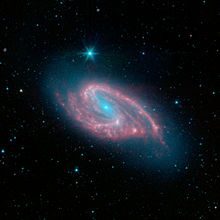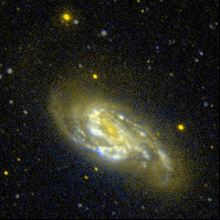Messier 66
J2000 epoch) | |
|---|---|
| Constellation | Leo |
| Right ascension | 11h 20m 15.026s[1] |
| Declination | +12° 59′ 28.64″[1] |
| Redshift | 0.002425±0.000010[2] (696.3±12.7 km/s)[3] |
| Distance | 31 Mly (9.6 Mpc)[4] |
| Apparent magnitude (V) | 8.9[2] |
| Characteristics | |
| Type | SAB(s)b[5] |
| Apparent size (V) | 9.1′ × 4.2′[6] |
| Notable features | Galaxy in the Leo Triplet |
| Other designations | |
| Arp 16, NGC 3627, PGC 34695, UGC 6346[7] | |
Messier 66 or M66, also known as NGC 3627, is an
M66 has a morphological classification of SABb,[5] indicating a spiral shape with a weak bar feature and loosely wound arms. The isophotal axis ratio is 0.32, indicating that it is being viewed at an angle.[5] M66 is receding from us with a heliocentric radial velocity of 696.3±12.7 km/s.[3] It lies 31[4] million light-years away and is about 95 thousand light-years across[11] with striking dust lanes and bright star clusters along sweeping spiral arms.
Five supernovae have been observed in M66: SN 1973R (type IIP, mag. 14.5),[12] SN 1989B (type Ia, mag. 13),[13] SN 1997bs (Type IIn, mag. 17),[14] SN 2009hd (Type II, mag. 15.8),[15] and SN 2016cok (Type IIP, mag. 16.6).[16][17][18] SN 2016cok was discovered by the All Sky Automated Survey for Supernovae.[19]
Gravitational interaction from its past encounter with neighboring NGC 3628 has resulted in an extremely high central mass concentration; a high
Gallery
-
Infrared false color view of M66 from the Spitzer Space Telescope
-
Infrared false color view of M66 from the James Webb Space Telescope
-
Messier 66 by 2MASS
-
An ultraviolet image of Messier 66 by GALEX
See also
- List of Messier objects
References
- ^ S2CID 18913331.
- ^ Springer-Verlag.
- ^ S2CID 117876537, 10.
- ^ S2CID 250737862, 50.
- ^ S2CID 119253507.
- ^ "NASA/IPAC Extragalactic Database", Results for NGC 3627, retrieved 31 August 2006.
- ^ "NGC 3627". SIMBAD. Centre de données astronomiques de Strasbourg. Retrieved 2 December 2018.
- ^ Frommert, Hartmut; Kronberg, Christine (15 June 2016), Spiral Galaxy M66, retrieved 3 December 2018.
- ^ ISBN 978-1107018372It is recorded as discovered by Pierre Méchain, but apparently this is an error.
- ISBN 978-3319653853
- small angle formula: 31 mly × tan( 9.1′ ) = ~82 kly. diameter
- ^ Transient Name Server entry for SN 1973R. Retrieved 24 March 2023.
- ^ Transient Name Server entry for SN 1989B. Retrieved 24 March 2023.
- ^ Transient Name Server entry for SN 1997bs. Retrieved 24 March 2023.
- ^ Transient Name Server entry for SN 2009hd. Retrieved 24 March 2023.
- Bibcode:2016ATel.9189....1S.
- ^ List of Supernovae, Central Bureau for Astronomical Telegrams, retrieved 9 September 2015
- ^ Transient Name Server entry for SN 2016cok. Retrieved 24 March 2023.
- ^ Lewis, Danny. "Spy Two Supernovae in June's Night Sky". Smithsonian. Retrieved 22 November 2019.
- doi:10.1086/173374.
External links
- Spiral Galaxy M66
- Astronomy Picture of the Day – Unusual Spiral Galaxy M66 from Hubble – 2010 April 13
- Messier 66 Close Up, APODJune 13, 2024
- Merrifield, Mike; Szymanek, Nik. "M66 – Spiral Galaxy". Deep Sky Videos. Brady Haran.
- Messier 66 on





